…click on the above link to read the rest of the article…
Home » Posts tagged 'of two minds' (Page 18)
Tag Archives: of two minds
We Are All Hostages of Corporate Profits
We Are All Hostages of Corporate Profits
Keynesian Economics Is an Artifact of Cheap Energy
Keynesian Economics Is an Artifact of Cheap Energy
…click on the above link to read the rest of the article…
Could Germany Fracture?
Could Germany Fracture?
All sorts of centralized organizations that appear rock-solid may well melt into air as the disintegrative dynamics gather momentum.
Rising political and social discord that is generally being attributed to “populism” may actually be the re-emergence of ancient geographic and cultural fault lines. An often-overlooked manifestation of this might be the nation-state of Germany, a possibility fleshed out by longtime correspondent Mark G.
It’s both convenient and expedient for politicos to blame “populism” for the fracturing of the status quo. Given the unsavory undertones of ethnic/religious bias of “populism,” this allows the media-savvy politico (and aren’t they all media-savvy?) to paint his/her opponents as racist via the code-word “populist.”
Labeling dissenters “populists” doesn’t explain or predict anything. In terms of economic classes, it’s more insightful to distinguish between the Protected Class (insiders and favored elites) who benefits enormously from the status quo and the Unprotected Class (outsiders, marginalized workers, those without privilege or access to cheap capital).
But this doesn’t exhaust the sources of profound social discord. As historian Peter Turchin explained in his recent book Ages of Discord, historical eras are either integrative periods in which people find reasons to cooperate and join forces, or disintegrative periods in which reasons to split apart become dominant.
Clearly, the world-system of this era is entering a disintegrative phrase, and dismissing dissenters as “populists” solves nothing. For insight on how the disintegrative phase may manifest in Germany, let’s turn to Mark G.’s commentary:
Merkel faces own ‘German BREXIT’ Chancellor’s immigration crisis is ‘Threat to Europe’
The breakdown of the Bavarian CSU and German CDU center-right coalition (refounded post WWII by Konrad Adenauer) is historic. And it has definite regional implications. I think we could be watching the beginning moves not in a “German Brexit” but in the political collapse of the modern German state into multiple components.
…click on the above link to read the rest of the article…
Make Capital Cheap and Labor Costly, and Guess What Happens?
Make Capital Cheap and Labor Costly, and Guess What Happens?
Employment expands in the Protected cartel-dominated sectors, and declines in every sector exposed to globalization, domestic competition and cheap capital.
If you want to understand why the global economy is failing the many while enriching the few, start with the basics: capital, labor and resources. What happens when central banks drop interest rates to near-zero? Capital becomes dirt-cheap. It becomes ludicrously easy to borrow money to buy whatever cheap capital can buy: stock buybacks, robots, automation tools, interest-sensitive assets such as housing, competitors or potential competitors, high-yield emerging-market bonds, and so on.
What happens when cartels take control of core domestic industries such as banking, defense, higher education and healthcare? Costs soar because competition has been throttled via regulatory capture, and these domestic sectors are largely non-tradable, meaning they can’t be offshored and have little meaningful exposure to globalization.
Labor-intensive cartels such as these can pass on their rising costs for labor, resources and profiteering. Do you really think assistant deans could be pulling down $250,000 annual salaries in higher education if there was any global or domestic competition?
As for healthcare, I’ve often noted that healthcare/sickcare will bankrupt the nation all by itself. When a cartel such as healthcare / sickcare can force higher prices on employers and employees, the cost of labor throughout the economy rises.
Sickcare Will Bankrupt the Nation–And Soon (March 21, 2011)
Can Chronic Ill-Health Bring Down Great Nations? Yes It Can, Yes It Will (November 23, 2011)
You Want to Fix the Economy? Then First Fix Healthcare (September 29, 2016)
As I’ve indicated on the chart, labor-intensive cartels in non-tradable sectors–higher education, defense/national security, healthcare and banking– can pass on their rising labor costs to their captive customers.
…click on the above link to read the rest of the article…
Dear High School Graduates: the Status Quo “Solutions” Enrich the Few at Your Expense
Dear High School Graduates: the Status Quo “Solutions” Enrich the Few at Your Expense
You deserve a realistic account of the economy you’re joining.
Dear high school graduates: please glance at these charts before buying into the conventional life-course being promoted by the status quo.
Here’s the summary: the status quo is pressuring you to accept its “solutions”: borrow mega-bucks to attend college, then buy a decaying bungalow or hastily constructed stucco box for $800,000 in a “desirable” city, pay sky-high income and property taxes on your earnings, and when the stress of all these crushing financial burdens ruins your health, well, we’ve got meds to “help” you–lots of meds at insane price points paid for by insurance– if you have “real” insurance without high deductibles, of course.
Here’s the truth the status quo marketers don’t dare acknowledge: every one of these conventional “solutions” only makes the problem worse. Student loan debt only makes your life harder, not easier, as the claimed “value” of a college degree is based on the distant past, not the present. The economy is changing fast and the conventional “solutions” no longer match the new realities. But don’t expect anyone profiting from the predatory profiteering higher-education cartel to admit this.
The high cost of housing isn’t “solved” by buying in at the top of an unprecedented bubble. Buying into bubbles only makes the problem worse, for all bubbles eventually pop.
The “solution” to crushing levels of debt is not to borrow more just to prop up a rotten, corrupt, dysfunctional and self-serving status quo. In effect, the young generations are being groomed to be the hosts for the parasitic classes that feed on young taxpayers, student loan debt-serfs, young buyers of bubble-priced housing, unaffordable sickcare “insurance” and all the rest of the status quo “solutions.”
…click on the above link to read the rest of the article…
Onward to Stock Market Nirvana… Or Not
Onward to Stock Market Nirvana… Or Not
Rising wedges tend to lead to declines, so ignore them.
At long last, we have reached the Nirvana of consensus: the stock market is heading to new all-time highs. Even the perma-Bear camp seems to have accepted the inevitability of new all-time highs ahead: The FANG stocks are hitting new highs, the Russell 2000 Small-Cap Index is hitting new highs, and the laggard S&P 500 is sure to catch up to its peers, as it climbs the ladder of higher lows. Once again we’ve reached the Nirvana of ever-higher stock valuations.
Or not. That troublesome kid watching the naked Emperor ride past in his imaginary finery keeps muttering about rising wedges. Consider the Russell Small-Cap Index (RUT):
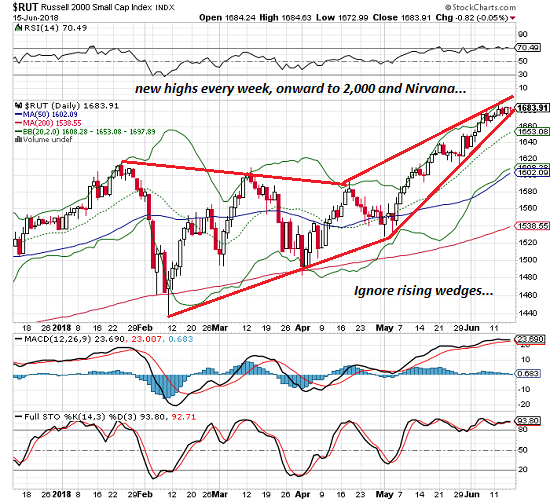
The Raging Bull of the FANG stocks, Netflix:
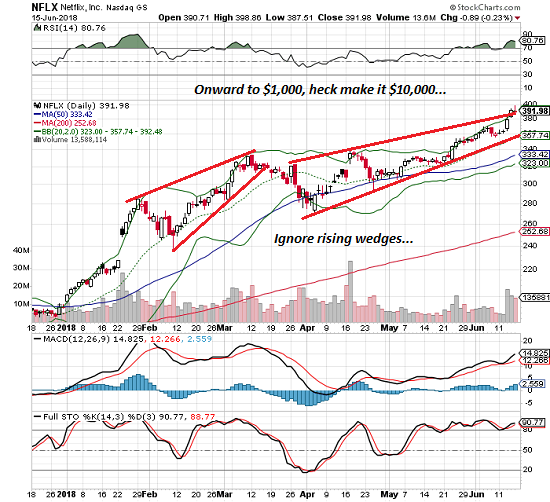
The S&P 500:

And the so-called “fear index,” the VIX, reduced to the Nirvana of complacency and supreme confidence:
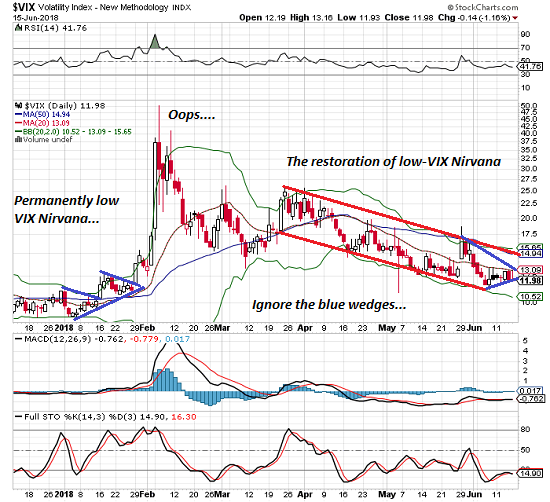
The Nirvana of January–super-low VIX and an ever-rising stock market– was disrupted by an unwelcome eruption of reality.
The beaten down VIX traced out a couple of blue wedges before the eruption, but let’s ignore them. What matters is order was restored to the Universe by the triumph of complacency and confidence as the VIX was ground down to sub-12 levels again.
Rising wedges tend to lead to declines, so ignore them. Never mind their ubiquity– Nirvana blasts right through resistance and rising wedges.
The faithless few might be troubled by the similarities of late January to the present, but the faithful have supreme confidence in the Fed, the tremendous bite of the FANGs and the all-powerful forces of greed and complacency–a marriage made in heaven!
Here’s a look at the real Nirvana: the income and wealth gains of the top .1%.
Debt-serfs “own” nothing but debt, the Technocrat class shouldering student loans and mortgages keeps the machine running by working themselves to exhaustion, and the speculative class skims virtually all the gains.
Stock market Nirvana feeds wealth/income inequality Nirvana.
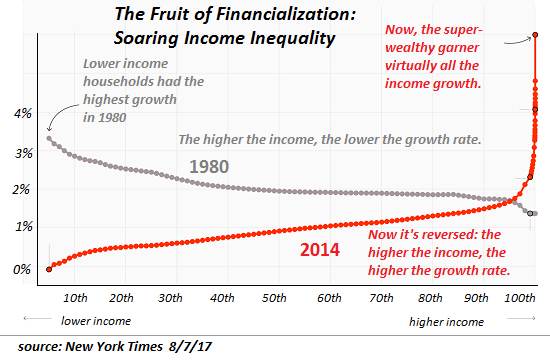
Here We Go Again: Our Double-Bubble Economy
Here We Go Again: Our Double-Bubble Economy
The bubbles in assets are supported by the invisible bubble in greed, euphoria and credulity.
Well, folks, here we go again: we have a double-bubble economy in housing and stocks, and a third difficult-to-chart bubble in greed, euphoria and credulity.
Feast your eyes on Housing Bubble #2, a.k.a. the Echo Bubble:
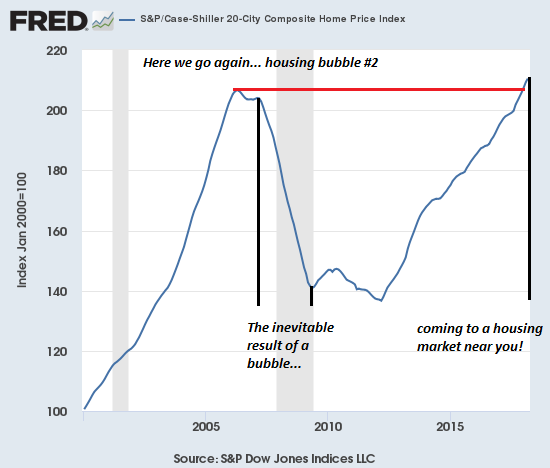
Here’s the S&P 500 stock index (SPX): no bubble here, we’re told, just a typical 9-year long Bull Market that has soared from a low in 2009 of 666 to a recent high of 2802 in January of this year:
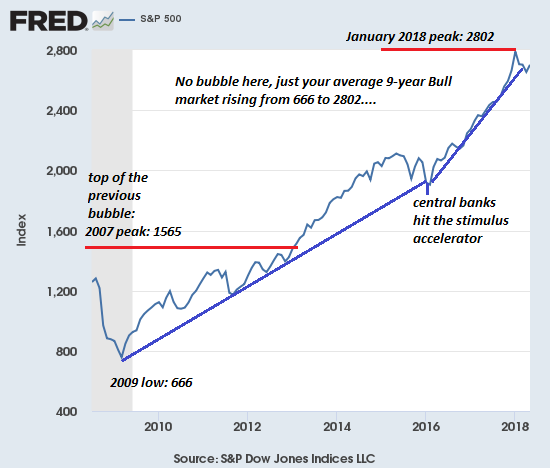
Here’s a view of the same bubble in the Dow Jones Industrial Average (DJIA):
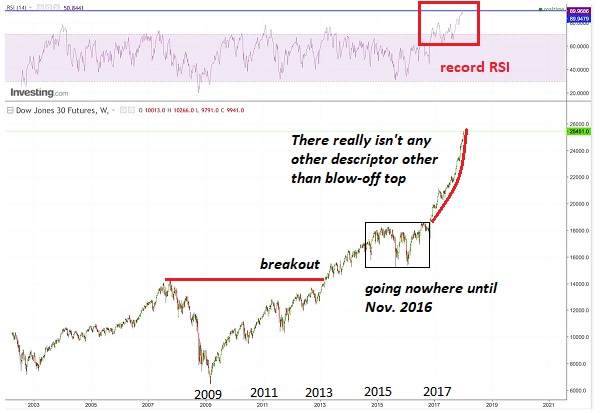
Is anyone actually dumb enough not to recognize these are bubbles? Of course not. Those proclaiming that “these bubbles are not bubbles” know full well they’re bubbles, but their livelihoods depend on public denial of this reality.
And so we’re inundated with justifications of bubble valuations, neatly bound with statistical mumbo-jumbo: forward earnings (better every day in every way!), P-E expansion, and all the rest of the usual blather that’s spewed by status quo commentators and fund managers at the top of every bubble.
The problem with bubbles is they always pop. The market runs out of Greater Fools and/or creditworthy borrowers, and so sellers overwhelm the thinning ranks of buyers.
Those dancing euphorically, expecting the music will never stop, are caught off guard (despite their confidence that they are far too clever to be caught by surprise), and the panic-driven crowd clogs the narrow exit, leaving a ballroom of bag-holders to absorb the losses.
The other problem with bubbles is that we’ve become dependent on them as props holding up a rotten, corrupt status quo. Since the economy can no longer generate sufficient prosperity to go around via actual increases in productivity and efficiency, those skimming most of the gains rely on “the wealth effect” generated by expanding asset bubbles to create a dreamy illusion of prosperity.
…click on the above link to read the rest of the article…
What’s Wrong with the Economy: 9 Toxic Dynamics
What’s Wrong with the Economy: 9 Toxic Dynamics
These nine dynamics are mutually reinforcing.
Beneath the surface signals of an eternally rising stock market and expanding GDP, we all sense something is deeply, systemically wrong with the U.S. economy. These nine structural dynamics generate secondary dynamics, all of which are toxic to social mobility, sustainable prosperity, accountability and democracy:
1. The financialization of the economy, which transformed services, credit, risk and labor into commodities that could be traded globally. Financialization generates enormously asymmetric returns: those with access to low-cost credit, global markets and expertise in finance collect the lion’s share of gains in income and wealth.
2. The technological transformation of the economy, which has placed a substantial scarcity premium on specific tech/managerial/communication skills and devalued ordinary labor and capital. As a result, the majority of gains in wealth and income flow to those with the scarce skills and forms of capital, leaving little for ordinary labor and capital.
3. The end of cheap fossil fuels. The fracking boom/bubble has obscured the long-term secular trend: the depletion of cheap-to-access and process oil. As many analysts have observed (Nate Hagens, Gail Tverberg, Richard Heinberg, Chris Martenson et al.), the global economy only grows if energy and credit are both cheap.
4. Globalization, which transformed the developing world into the environmental dumping ground of the wealthy nations and enabled the owners of capital to offshore waste and labor.
5. The destructive consequences of “growth at any cost” are piling up. “Growth” is the one constant of all existing political-economic systems, and none of the current Modes of Production (i.e. the structures that organize production, consumption, the economy and society) recognize that “growth” is not sustainable.
The first two dynamics drive three other dynamics that have hollowed out the productive economy:
…click on the above link to read the rest of the article…
The Three Crises That Will Synchronize a Global Meltdown by 2025
The Three Crises That Will Synchronize a Global Meltdown by 2025
We’re going to get a synchronized global dynamic, but it won’t be “growth” and stability, it will be DeGrowth and instability.
To understand the synchronized global meltdown that is on tap for the 2021-2025 period, we must first stipulate the relationship of “money” to energy:“money” is nothing more than a claim on future energy. If there’s no energy available to fuel the global economy, “money” will have little value.
The conventional economists assure us that energy is now a small part of the overall economy, so fluctuations in energy prices will have a limited effect on global prosperity. But what’s left of global prosperity when energy is unable to meet current demand at any price that consumers can afford?
The current “economic understanding” of energy and “money” is an artifact of a unique period of cheap, abundant fossil fuels. It is an article of faith in economics that energy will always become cheaper and more abundant as the pixie-dust of technology is irreversible. By the time fossil fuels become scarce many decades hence, we’ll all have cold-fusion generators, or micro-nuclear power plants or nearly free electricity from solar panels, and so on.
This is of course complete rubbish. To scale up any energy source to replace fossil fuels will require decades and tens of trillions of dollars in capital investment. In other words, energy development is a financial dynamic. Technology is only the first small piece of a much larger puzzle.
This becomes clear when we ponder the unwelcome reality that the fracking miracle has resulted in $250 billion in losses. You mean all those companies lost money exploiting the miracle technologies of fracking?
…click on the above link to read the rest of the article…
The U.S. Economy In Two Words: Asymmetric Gains
The U.S. Economy In Two Words: Asymmetric Gains
The Status Quo is in trouble if the bottom 95% wake up to the asymmetric gains that are the only possible output of our hyper-financialized economy.
The core dynamic of the U.S. economy in this era is asymmetric gains: the gains in income, wealth and power are increasingly concentrated in the top slice of the economy and society, while the income, wealth and power of the majority stagnate or decline.
The Status Quo must paper over this widening gulf with threadbare narratives that no longer match reality: for example, we’re an ownership society. We sure are: the vast majority of the nation’s productive assets are owned by the top 5%.
The U.S. economy has changed, but the transformation is largely invisible to the average participant and conventional economist. The previous iteration of the economy expired in the 1970s, an era of stagflation (stagnant growth and rising inflation that eroded the purchasing power of most households), higher energy costs and increasing global competition, an era in which the “external costs” of industrial-scale pollution finally came home to roost and the early stages of digital technologies began impacting human labor.
Stocks and bonds were destroyed in the 1970s. Investing capital in industrial production no longer generated outsized profits.
The 1980s ushered in a New Economy based on financial magic: the outsized profits flowed to those with access to credit and the tools of financialization: buying assets with borrowed money, selling the assets off in the global marketplace and reaping enormous gains by producing no goods or services.
We now inhabit a hyper-financialized economy in which the only way to get ahead is to speculate. For the middle class, this means speculating in housing: if you hit the jackpot and your house soars in value, then leverage this new wealth into the cash needed to buy a second property–or extract the equity to fund a more luxe lifestyle.
…click on the above link to read the rest of the article…
Burrito Index Update: Burrito Cost Triples, Official Inflation Up 43% from 2001
Burrito Index Update: Burrito Cost Triples, Official Inflation Up 43% from 2001
Welcome to debt-serfdom, the only possible output of the soaring cost of living.
Long-time readers may recall the Burrito Index, my real-world measure of inflation. The Burrito Index: Consumer Prices Have Soared 160% Since 2001 (August 1, 2016). The Burrito Index tracks the cost of a regular burrito since 2001. Since we keep detailed records of expenses (a necessity if you’re a self-employed free-lance writer), I can track the cost of a regular burrito at our favorite taco truck with great accuracy: the cost of a regular burrito has gone up from $2.50 in 2001 to $5 in 2010 to $6.50 in 2016.
It’s time for an update: the cost of a regular burrito has now reached $7.50, triple the 2001 cost. That’s a 200% increase in 17 years. According to the federal government, inflation since 2001 has risen about 40%: what $1 bought in 2001 now costs $1.43, according to the BLS Inflation calculator.
The Burrito Index is five times the official inflation rate. As I noted in The Disaster of Inflation–For the Bottom 95% (October 28, 2016) and Inflation Isn’t Evenly Distributed: The Protected Are Fine, the Unprotected Are Impoverished Debt-Serfs (May 25, 2017), the gross under-reporting of inflation (i.e. the loss of purchasing power of “money” and labor) is only part of the distortion: some of the populace is protected by subsidies from the real ravages of inflation, while those exposed to the unsubsidized real-world costs are being savaged by supposedly benign inflation.
Lest you reckon only burritos have tripled in cost since 2001–have you checked out college tuition or rents lately? Consider a typical public university:
University of California at Davis:
2004 in-state tuition $5,684
2018 in state tuition $14,463
So tuition at a state university soared 2.5 times while official inflation rose by a mere 35% since 2004. If UCD tuition had only risen by 35%, it would total $7,673, not $14,463. The cost above and beyond what we would expect had tuition tracked official inflation adds up to $27,000 per four-year bachelor’s degree per student.
…click on the above link to read the rest of the article…
How Systems Collapse
How Systems Collapse
This is how systems collapse: faith in the visible surface of abundance reigns supreme, and the fragility of the buffers goes unnoticed.
I often discuss systems and systemic collapse, and I’ve drawn up a little diagram to illustrate a key dynamic in systemic collapse. The key concepts here are stability and buffers. Though complex systems are never static, but they can be stable: that is, they ebb and flow within relatively stable boundaries supported by reserves, i.e. buffers.
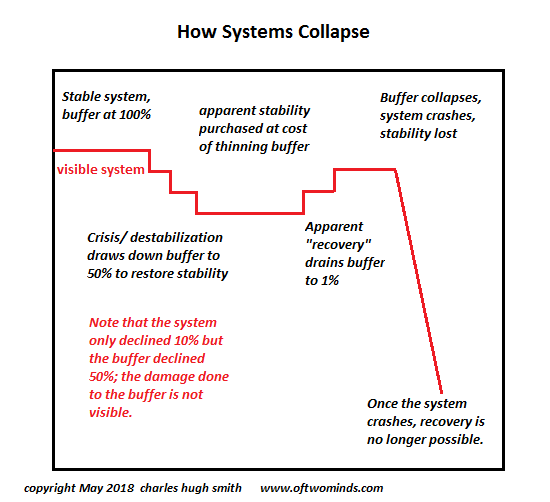
In ecosystems, this ebb and flow is expressed in feedback loops between the weather, environment and plant/animal species which inhabit the ecosystem. Ideal weather/food conditions may spark a rise in an insect population, for example, which then enables an increase in insect-predator populations (fish, birds, frogs, etc.) which then increases the consumption of the insects and reduces the impact of the higher insect population.
Fluctuations within this dynamic generate feedback that tends to reduce extremes and restore dynamic equilibrium.
In the human sphere, ideal weather increases crop yields which then enables a larger human population. When lean years replace fat years, the populace suffers from a lack of calories and births decline and deaths from disease rise as weakened individuals are more vulnerable to infections, etc.
In this example, reserve supplies of water and food are buffers that smooth out periods of want and instability. Suppose the populace depends on a river for irrigation and human consumption (cooking, bathing, etc.). If the river runs low, the populace relies on wells for reserves of water. In good harvests, grain is set aside for lean harvests; the wells and grain stores are buffers which can be drawn down to restore stability to a stressed system.
…click on the above link to read the rest of the article…
The Next Recession Will Be Devastatingly Non-Linear
The Next Recession Will Be Devastatingly Non-Linear
The acceleration of non-linear consequences will surprise the brainwashed, loving-their-servitude mainstream media.
Linear correlations are intuitive: if GDP declines 2% in the next recession, and employment declines 2%, we get it: the scale and size of the decline aligns. In a linear correlation, we’d expect sales to drop by about 2%, businesses closing their doors to increase by about 2%, profits to notch down by about 2%, lending contracts by around 2% and so on.
But the effects of the next recession won’t be linear–they will be non-linear, and far more devastating than whatever modest GDP decline is registered. To paraphrase William Gibson’s insightful observation that “The future is already here — it’s just not very evenly distributed”: the recession is already here, it’s just not evenly distributed– and its effects will be enormously asymmetric.
Non-linear effects can be extremely asymmetric. Thus an apparently mild decline of 2% in GDP might trigger a 50% rise in the number of small businesses closing, a 50% collapse in new mortgages issued and a 10% increase in unemployment.
Richard Bonugli of Financial Repression Authority alerted me to the non-linear dynamic of the coming slowdown. I recently recorded a podcast with Richard on one sector that will cascade in a series of non-linear avalanches once the current asset bubbles pop and the current central-bank-created “recovery” falters under its staggering weight of debt, malinvestment and speculative excess.
The Intensifying Pension Crisis (37-minute podcast)
The core dynamic of the next recession is the unwind of all the extremes:extremes in debt expansion, in leverage, in the explosion of debt taken on by marginal borrowers, in malinvestment, in debt-fueled speculation, in emerging market debt denominated in US dollars, in financial repression, in political corruption–the list of extremes that have stretched the system to the breaking point is almost endless.
…click on the above link to read the rest of the article…
Our Economy Is Failing Our Society
Our Economy Is Failing Our Society
If we want to extend the opportunities for positive social roles to everyone, we have to change the way money is created and distributed in our economy.
One of the most unrecognized dynamics of our era is the structural dependence of our society on our economy. One set of pundits, politicos and academics wring their hands over the fragmenting of civil society (the rise of disintegrative, divisive forces and the decay of integrative forces) and decry the rising inequality that is our economy’s dominant feature, while another set of pundits and academics celebrate the economy’s remarkable adaptability or focus solely on reading financial tea leaves (interest rates, Fed policy tweaks, unemployment rates, etc.)
Those few analysts who escape their respective silos/academic ghettos rarely get past generalities such as the erosion of social mobility, a dynamic that is clearly economic and social. But the precise mechanisms behind the secular erosion of social mobility are lost in platitudes about how A.I. and robots will free us all to be poets or consumers of a vast and endlessly enjoyable leisure.
The key understanding that’s lacking is that economic structures organize and limit the social structures underpinning civil society. To understand why civil society is disintegrating on so many fronts (public health, civil discourse, etc.), we must understand how our economy has failed to support the social structures required for an integrative, inclusive civil society.
Our economy is transforming/adapting as a result of powerful secular trends:the 4th Industrial Revolution (a.k.a. the digital-networked-AI-Big-Data revolution), globalization, the commoditization of ordinary capital and labor, the financial and political dominance of quasi-monopolies and cartels, and perhaps the most unrecognized dynamic, the devaluation of ordinary capital and labor in favor of scarce and often rarified forms of capital and labor in the fields of technology, entrepreneurship and finance.
…click on the above link to read the rest of the article…
Sustainability Boils Down to Scale
Sustainability Boils Down to Scale
Only small scale systems can sustainably impose “skin in the game”– consequences, accountability and oversight.
Several conversations I had at the recent Peak Prosperity conference in Sonoma, CA sparked an insight into why societies and economies thrive or fail: It All Boils Down to Scale. In a conversation with a Peak Prosperity member who goes by MemeMonkey, MemeMonkey pointed out that social / economic organizations that function well at small scales (i.e. localized) fail when scaled up and centralized (i.e. globalized).
I was immediately struck by the impact of scale on markets (Capitalism) and the state (Socialism), an ideological spectrum I’ve written about recently.
Both markets and governance function well at a small scale because those making the decisions must absorb the consequences of their actions/choices.
In large-scale centralized systems, those at the top of the wealth-power pyramid who wield the greatest influence are typically immune from the consequences of their (self-serving) decisions.
Indeed, the entire point of centralized hierarchies is to buffer top decision-makers from the consequences of their actions and choices.
This ties directly into Nassim Taleb’s most recent popularization of the critical role played by participants having “skin in the game,” i.e. exposure to the consequences of their actions and choices.
In a small localized group, it’s basically impossible for anyone, even those at the top of the local welth-power pyramid, to escape the consequences of extractive activities that disupt the local ecosystem.
For example, should overfishing destroy the local fisheries, even the leaders no longer have access to fish.
Should the leadership pursue a conflict with a neighboring tribe, the leaders are just as likely to be killed or maimed as any participant (and very possibly more likely to be killed/injured, as leaders are naturally high-value targets).
…click on the above link to read the rest of the article…



